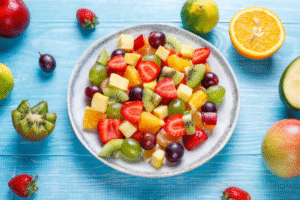Fruit salad is a simple and healthy dish that mixes fresh fruits into a vibrant, tasty bowl. You can use almost any fruit you like, which makes it easy to customize based on what you enjoy or what’s in season. Some of the most common fruits you’ll find in fruit salad include strawberries, bananas, apples, oranges, kiwis, blueberries, grapes, and pineapple. Each fruit adds a unique flavor and texture, making the salad both delicious and interesting.
The beauty of fruit salad is that it’s versatile. You can create different combinations, depending on your mood or the time of year. For example, in the summer, you might enjoy a mix of juicy watermelon and berries, while in the winter, you might prefer apples, citrus fruits, and pomegranate seeds. Adding a little lemon or lime juice can brighten up the flavors, and if you like it sweeter, a drizzle of honey or agave syrup can give it that extra sweetness. The options are endless!
Fruit Salad Calories: How Many Calories Are in a Fruit Salad?
The calorie count in a fruit salad can vary based on the fruits you choose and any extra ingredients you add. On average, a one-cup serving of plain fruit salad will range from 90 to 150 calories. The exact number depends on the fruits used, as some fruits are naturally higher in calories than others. For example, bananas have 134 calories per cup, while strawberries have only 50 calories per cup. This difference shows how diverse the calorie content can be, even in a single fruit salad.
The key to keeping your fruit salad low-calorie is to stick with fresh fruits and avoid adding sugary extras. While whipped cream, sweetened yogurt, or syrups can make the salad more indulgent, they also increase the calorie count significantly. If you’re keeping an eye on calories, it’s best to skip those added ingredients and let the natural sweetness of the fruit shine through. By doing so, you can enjoy a tasty treat that’s also light on the calories!
Health Benefits of Fruit Salad
Fruit salad isn’t just a tasty treat—it’s a nutritional powerhouse! First and foremost, fruits are rich in vitamins and minerals, which are essential for your overall health. For example, fruits like strawberries, oranges, and kiwis are high in vitamin C, which boosts your immune system. Bananas provide potassium, which is great for heart health and muscle function. Each fruit offers its own unique set of nutrients, so eating a variety gives you a broad range of health benefits.
Fruits are also packed with antioxidants, which help fight inflammation and protect your body from harmful free radicals. Many fruits, like watermelon and grapes, are also high in water content, helping you stay hydrated. Plus, the fiber found in fruits aids digestion and helps you feel fuller for longer, making fruit salad a great choice if you’re looking to control your appetite or manage your weight. It’s a sweet and healthy snack all in one!
How to Make a Healthy Fruit Salad
Making a healthy fruit salad is easy, and it doesn’t require much effort to make it both nutritious and delicious. Start by selecting a variety of fruits with different colors and textures. This not only makes your salad look appealing but also ensures that you’re getting a wide range of nutrients. For example, mixing berries, citrus fruits, and melons will give you a good mix of vitamins, fiber, and antioxidants.
When preparing the fruit, make sure to wash everything thoroughly, and peel or remove any seeds or tough skins that might be inedible. Cut the fruit into uniform pieces so that everything is easy to mix. To keep your fruit salad fresh and prevent browning, add a little lemon or lime juice. If you like it sweeter, you can drizzle a small amount of honey or agave, but remember, a little goes a long way. Skip the heavy dressings or sugary additions to keep it healthy and light.
Fruit Salad Calorie Boosters: What to Watch For
Fruit salad can be a healthy treat, but it’s important to be mindful of what you add to it, as some ingredients can quickly turn your salad into a calorie bomb. For instance, toppings like whipped cream, sweetened yogurt, or marshmallows are all high in calories and sugar. These can make your otherwise healthy fruit salad much less nutritious.
If you add canned fruits in syrup, you’re also increasing the sugar content, which could raise the calorie count without adding much nutritional value. Instead, stick to fresh fruits, which provide vitamins, fiber, and antioxidants. If you really want to enhance the flavor, a splash of citrus juice or a few fresh herbs like mint can do wonders without adding extra calories. By keeping it simple and avoiding sugary extras, you can enjoy a healthy, refreshing fruit salad that’s both low in calories and high in nutrients.
Creative Ways to Enjoy Fruit Salad
Fruit salad doesn’t have to be boring or repetitive! There are plenty of creative ways to enjoy it that go beyond just eating it as a snack. One fun idea is to serve it over low-fat yogurt or cottage cheese for a protein-packed breakfast. This adds creaminess and extra nutrients while keeping the dish light. You could also pair fruit salad with a handful of nuts or seeds for a crunchy, satisfying snack that provides healthy fats and protein.
For a dessert-like treat, try layering fruit salad with Greek yogurt and granola to make a delicious and healthy parfait. If you’re in the mood for something cool, freeze the fruit salad in popsicle molds for a refreshing treat on a hot day. The possibilities are endless, so don’t be afraid to experiment with different combinations and find what works best for you!
How Fruit Salad Compares to Other Snacks
When compared to many other snacks, fruit salad is a much healthier option. It’s low in fat, has no cholesterol, and is full of vitamins and fiber. Unlike chips or candy, fruit salad can help you feel full and give your body the nutrients it needs.
Health Benefits of Fruit Salad
Eating fruit salad isn’t just about satisfying your sweet tooth—it’s also great for your health! Here’s why:
- Packed with Vitamins and Antioxidants: Fruits like strawberries, oranges, and kiwis are full of vitamin C, which helps keep your immune system strong.
- High in Fiber: Fiber helps your body digest food better and makes you feel full, which can help with weight control.
- Hydrating: Many fruits have a lot of water in them, which helps you stay hydrated.
-
Low in Fat: Fruit salad is naturally low in fat and contains no cholesterol, which makes it a healthy choice.
How to Make a Healthy Fruit Salad
Making a healthy fruit salad is easy, but here are some tips to make sure you’re getting the most out of your dish:
-
Pick a Variety of Fruits
Choose fruits of different colors and textures. This not only looks nice but also gives you a wider range of nutrients.
-
Prep the Fruit Carefully
Wash all the fruit well. Peel or remove seeds and skins if needed. Cut the fruit into bite-sized pieces for easy mixing.
-
Enhance the Flavor Naturally
Add a little splash of lemon or lime juice to keep the fruit fresh and prevent browning. You can also add fresh herbs like mint for extra flavor.
-
Skip the Sugary Additions
Avoid adding heavy dressings, whipped cream, or canned fruit in syrup. These can add unnecessary sugar and calories to your salad.
Watch Out for These Fruit Salad Calorie Boosters
While fruit salad is usually healthy, some additions can turn it into a high-calorie dish. Here’s what you might want to avoid or use only a little of:
- Added Sugars: Sweetened yogurt or syrups can increase both the sugar and calories.
- Creamy Toppings: Toppings like whipped cream or condensed milk can quickly add fat and calories.
- Processed Additions: Things like marshmallows or chocolate chips might make the salad more fun, but they also add extra calories.
For the healthiest fruit salad, stick to fresh fruit and natural flavor boosters.
Creative Ways to Enjoy Fruit Salad
Fruit salad doesn’t have to be the same every time. Here are some fun ideas to switch it up:
- For Breakfast: Serve your fruit salad over yogurt or cottage cheese for some extra protein.
- As a Snack: Pair your fruit salad with nuts or seeds for a balanced snack.
- For Dessert: Layer your fruit salad with Greek yogurt and granola for a tasty parfait.
- Frozen Fruit Salad: Freeze fruit salad in popsicle molds for a cool treat.
Sample Healthy Fruit Salad Recipe
Here’s a simple and healthy fruit salad recipe you can try!
Ingredients:
- 1 cup strawberries, sliced (50 calories)
- 1 cup blueberries (84 calories)
- 1 cup pineapple, diced (82 calories)
- 1 cup grapes, halved (104 calories)
- 1 orange, segmented (85 calories)
- Juice of 1 lime (8 calories)
- Fresh mint leaves (optional)
Instructions:
- Wash and prepare all the fruit.
- Combine the fruit in a large bowl.
- Squeeze the lime juice over the fruit and toss gently.
- Garnish with mint leaves if you like.
- Serve right away or chill it in the fridge.
Total Calories per Serving (1 cup): About 93 calories.
Feel free to swap out the fruits for your favorites or whatever’s in season!
Final Thoughts
Fruit salad is a healthy, delicious treat that can fit into any diet. By making smart choices with your ingredients, you can keep the calorie count low while still enjoying a sweet, refreshing snack. Plus, if you’re a blogger or website owner, getting niche-specific backlinks can help your site grow and reach more people interested in healthy eating.
So, next time you make a fruit salad, remember: it’s not just about taste—it’s also about taking care of your health and building your online presence!






